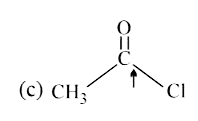In which of the following pairs, indicated bond is of greater strength :
CH3−CH=CH−↑ Br and CH3−−→C∣BrH−CH3
The correct Answer is:I
To determine which bond is stronger between the two given compounds, we need to analyze the stability of the resulting carbocations after the bond breaks. Let's break down the solution step by step.
Step 1: Identify the Compounds
We have two compounds:
1. Compound A: CH3−CH=CH↑Br
2. Compound B: CH3↑Br−CH−CH3
Step 2: Draw the Carbocations
When the bond with bromine (Br) breaks, it will leave behind a carbocation in both cases.
- For Compound A:
- The bond between the CH and Br breaks, resulting in:
CH3−CH+−CH
Here, the positive charge is on the sp² hybridized carbon.
- For Compound B:
- The bond between the Br and CH breaks, resulting in:
CH3−CH+−CH3
Here, the positive charge is on a carbon that is sp³ hybridized.
Step 3: Analyze Carbocation Stability
The stability of carbocations can be influenced by several factors, including hybridization and inductive effects.
- Compound A: The carbocation formed has a positive charge on an sp² hybridized carbon. This carbon is more electronegative and less stable due to the lack of electron-donating groups around it. The sp² carbon has less hyperconjugation compared to sp³.
- Compound B: The carbocation formed has a positive charge on an sp³ hybridized carbon. The presence of two CH3 groups provides a +I (inductive) effect, which stabilizes the positive charge through hyperconjugation and electron donation.
Step 4: Compare Bond Strength
Since the stability of the carbocation formed from Compound B is greater than that from Compound A, we can conclude that the bond in Compound A is stronger. This is because a more stable carbocation means the bond is more likely to break easily.
Conclusion
The bond in Compound A ( CH3−CH=CH↑Br ) is of greater strength compared to the bond in Compound B ( CH3↑Br−CH−CH3 ).
---
We have two compounds:
1. Compound A: CH3−CH=CH↑Br
2. Compound B: CH3↑Br−CH−CH3
When the bond with bromine (Br) breaks, it will leave behind a carbocation in both cases.
- The bond between the CH and Br breaks, resulting in:
CH3−CH+−CH
Here, the positive charge is on the sp² hybridized carbon.
- The bond between the Br and CH breaks, resulting in:
CH3−CH+−CH3
Here, the positive charge is on a carbon that is sp³ hybridized.
The stability of carbocations can be influenced by several factors, including hybridization and inductive effects.
Since the stability of the carbocation formed from Compound B is greater than that from Compound A, we can conclude that the bond in Compound A is stronger. This is because a more stable carbocation means the bond is more likely to break easily.
The bond in Compound A ( CH3−CH=CH↑Br ) is of greater strength compared to the bond in Compound B ( CH3↑Br−CH−CH3 ).
Topper's Solved these Questions
- BOOK - MOTIONCHAPTER - GOCEXERCISE - Exercise - 344videos
GOC
- BOOK - MOTIONCHAPTER - GOCEXERCISE - Exercise - 4 Level - I13videos
GOC
- BOOK - MOTIONCHAPTER - GOCEXERCISE - Exercise - 2 (Level - I)31videos
GOC
- BOOK - MOTIONCHAPTER - GASEOUS STATE EXERCISE - EXERCISE-4( LEVEL-II)19videos
GASEOUS STATE
- BOOK - MOTIONCHAPTER - GRIGNARD REAGENTEXERCISE - EXERCISE-216videos
GRIGNARD REAGENT
Similar Questions
Knowledge Check
- Question 1 - Select One
The correct IUPAC name of the following is:
H3C−CH=C∣CH3Br−C∣BrH−CH3A4-Bromo-3-methylpent-2-eneB2-Bromo-3-methylpent-4-eneC3-Methyl-2-bromopent-4-eneD2-Bromo-2-methylpent-2-ene
In which of the following pairs, indicated bond is of greater strength :
CH2=CH−↑ CH=CH2 and CH2=CH−↑ CH2−CH3View SolutionIn which of the following pairs, indicated bond having less bond dissociation energy :
CH3−C≡↑CH and HC≡↑CHView SolutionGive IUPAC name of the following organic compound :
CH3CH=C∣CH3−C∣BrH−CH3View SolutionCH3CH=CH−CH3+Br2→CH3−C∣BrH−C∣BrH−CH3 is an
View SolutionGive the IUPAC name of the compound CH3CH=C∣CH3−C∣BrH−CH3.
View SolutionWrite IUPAC name of CH3−C∣BrH−C∣CHOH−CH3
View SolutionWhich would undergo SN1 reaction faster in the following pair ?
CH3−CH2−CH2−Br and CH3−C∣BrH−CH3View Solution


 and
and